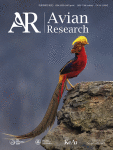
Fuchs J, De Swardt DH, Oatley G, Fjeldså J, Bowie RCK. Habitat-driven diversification, hybridization and cryptic diversity in the Fork-tailed Drongo (Passeriformes: Dicruridae: Dicrurus adsimilis). Zool Scr. 2018;00:1–19. https://doi.org/10.1111/zsc.12274
If anybody could send me a copy of this paper, I would be much obliged.
Last edited:





